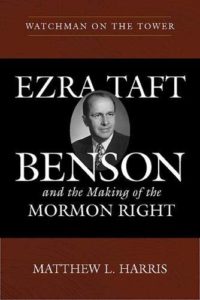Review
Title: Watchman on the Tower: Ezra Taft Benson and the Making of the Mormon Right
Author: Matthew L. Harris
Publisher: University of Utah Press
Genre: Non-Fiction, Biography
Year Published: 2020
Number of Pages: 233
Binding: Paperback
ISBN: 9781607817574
Price: $$34.95
Reviewed by Kevin Folkman for the Association for Mormon Letters
Members of the Church of Jesus Christ of Latter-day Saints under a certain age may not know how polarizing Ezra Taft Benson was among members and church leadership during the decades of the 50s and 60s. As President of the church after 1985, he is remembered for his fervent patriotism, his conference talks about the Book of Mormon, or proudly wearing his Boy Scout uniform. An apostle since 1943, some may not recall that Benson served as President Eisenhower’s Secretary of Agriculture during some of the hottest years of the Cold War. Benson was a staunch conservative, opposed to the programs of the New Deal, and an avid anti-communist. He was an outspoken critic of the Civil Rights movement. After his service in Eisenhower’s cabinet, Benson even came to believe that Eisenhower had allowed himself to be fooled and his administration infiltrated by communist agents. Following his government service, Benson became a vocal supporter of the anti-communist John Birch Society, although he never became a member.
In Watchman on the Tower: Ezra Taft Benson and the Making of the Mormon Right, Colorado State University professor Matthew L. Harris documents Benson’s service in government while concurrently serving as an apostle of the LDS church, and his continued political involvement in extreme right-wing ideologies and conspiracy theories after leaving government service. Watchman on the Tower is in many ways a difficult read. In this well-researched and documented book, Harris catalogs a long list of publications, sermons, statements, and actions that often seemed more in line with Benson’s political beliefs than his church responsibilities.
Harris writes of Benson’s fear of subversive elements, based on his reading of the Book of Mormon and its stories about the Gadianton Robbers, a “secret combination” conspiring to overthrow governments in the keynote Mormon scripture. Benson saw the communist movement as an extension of these ancient conspiracies, forming an existential threat to American freedom and liberty. In Harris’s narrative, Benson’s writings and sermons catalyzed a major shift to conservative politics in Utah and the LDS church. Fearing America was sliding into socialism and communism, Benson expressed concerns about federal welfare programs, the Civil Rights movement as a communist front, and Martin Luther King, Jr, as a communist agent. So vocal was he about these and other topics that other church leaders were concerned he was harming the church’s public image. Harris tells of a special meeting in New York City in 1970 where several of the apostles and prominent LDS businessmen met to discuss the problem. Humbled by the discussion, Benson ceased public pronouncements about civil rights.
Benson, however, continued his anti-communist rhetoric in writings and general conference addresses. His long association with the John Birch Society, although never a member, alarmed his fellow apostles and many lay church members, some of whom wrote to Presidents McKay and Joseph Fielding Smith, expressing their concerns.
Harris’s book is not very long, at only about 125 pages of text without notes and bibliography, but packed with stories about Benson’s life, including many I had not previously known. With its brevity, Watchman on the Tower can seem harsh at times, focusing on the conflicts Benson created. Harris is not writing a full biography but instead showing how Benson’s often extreme words and actions influenced politics in Utah and the church. However, Harris also uses some unfortunate word choices that seem deliberately provocative. In one instance, he describes Benson and fellow conservative Cleon Skousen descending into “near hysteria” over a perceived conspiracy to subvert free-market economics [p 98]. In another, Benson “groused” over changes in Medicaid and Social Security during the Carter Administration [p 92]. Harris writes conservative TV and internet personality Glenn Beck “snapped” about perceived socialism in the United States in a broadcast that featured one of Benson’s sermons [p 118]. These are just a few of the occasions where Harris presupposes the inner thoughts of his subjects.
For many, Benson was a beloved apostle and President of the Church of Jesus Christ of Latter-day Saints. Many still revere some of his most strident statements and study his political writings. Watchman on the Tower poses questions about the role one’s political views may play in the LDS church, whether conservative or liberal. During the 1950s, Ezra Taft Benson presented a positive image for the LDS church. Harris shows how that image became tarnished in the last third of the century as the church moved towards greater diversity, equality, and inclusivity. Benson, along with many members of the church, had to make that transition. As Church President, Benson accepted and promoted those same values. Despite the few concerns previously noted, Harris’s book is a valuable addition to understanding Benson’s role in church history and politics in the mid-20th century. Perhaps its most important quality is portraying Benson himself as a church leader in full relief, something previous biographies have not done. Ezra Taft Benson’s legacy has the potential to invoke strong emotions, both positive and negative. That duality is reflected in my own remembrances of President Benson.

